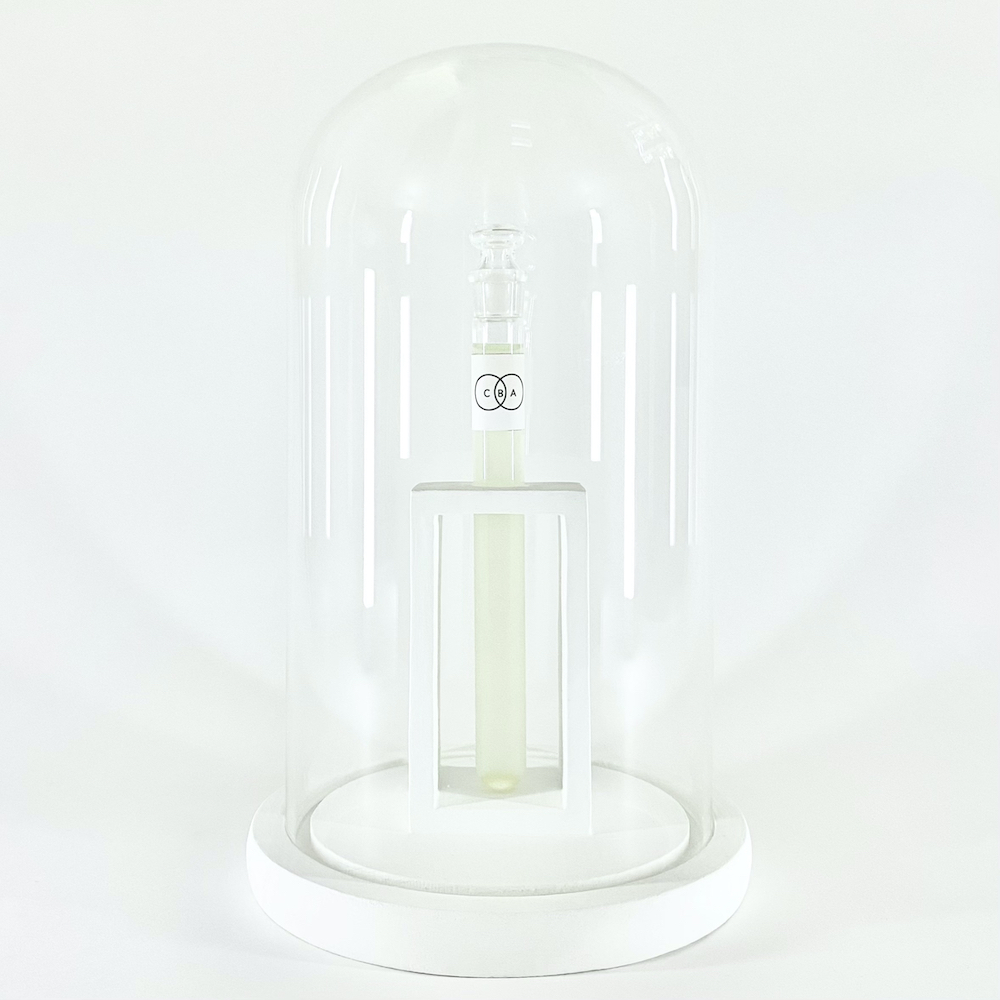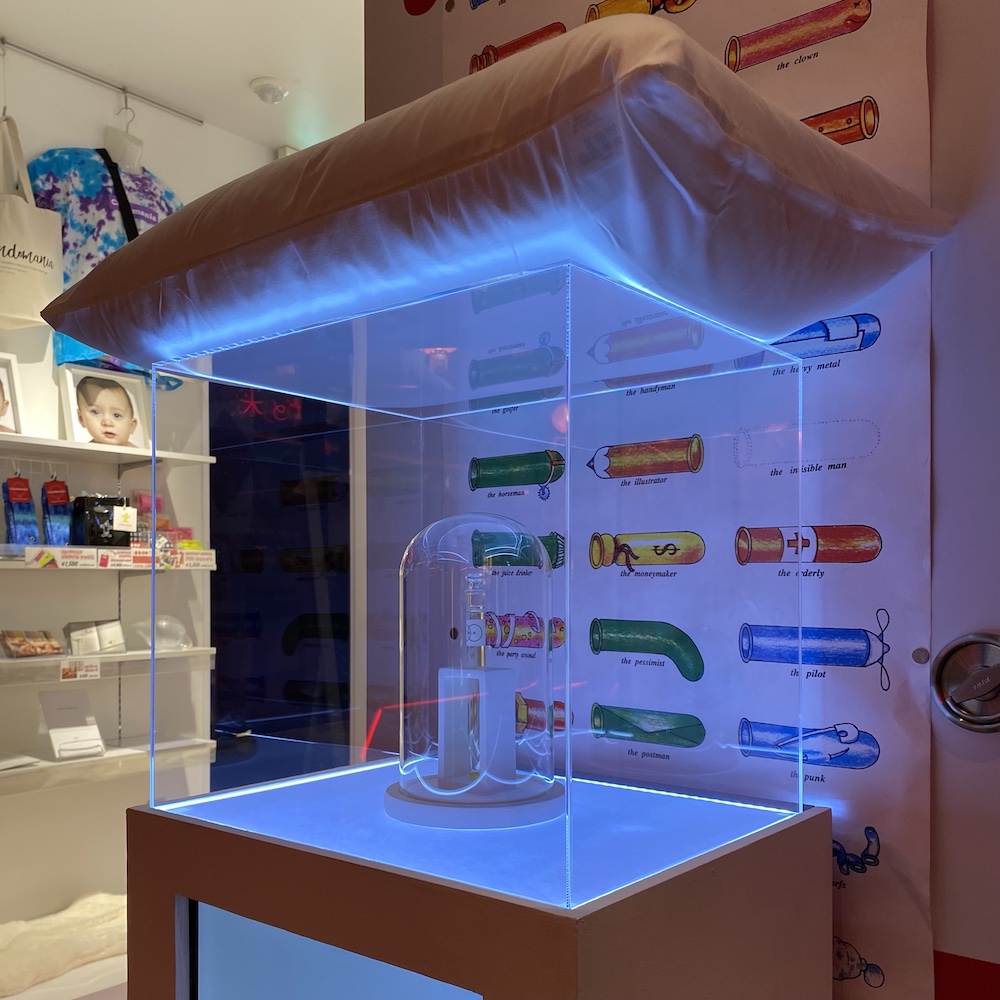news artists about contact

CBA
2023
A Perfume of Condom and Aphrodisia
CBA, a new work by the art group YAP, is made from condom-soaked alcohol and aphrodisiac scents. The condom, a contraceptive, evokes population control, while the romantic scents of ylang-ylang, jasmine, and neroli evoke population growth. The fragrance, which is like hitting the brake and accelerator at the same time, contains a glamorous yet complex question about contemporary society's demographic problems. This new art perfumery, CBA, is not a political statement on current demographic issues, but an attempt to draw attention to the population itself.
コンドームと催淫の香水
アートグループYAPによる新作『CBA』は、コンドームを漬け込んだアルコールと、催淫作用のあるの香りでつくられている。避妊具であるコンドームは人口抑制を、イランイラン、ジャスミン、ネロリなどのロマンティックな香りは人口増加を連想させる。まるでブレーキとアクセルを同時に踏むようなこの香りには、人口問題を抱える現代社会に対する、華やかなながらも複雑な問いが含まれている。この新しいアートパフューマリー『CBA』は、現状の人口問題について政治的な意見を述べるものではなく、人口それ自体に関する注意喚起を試みている。
installation view
ACCELBRAKE, 2023, CondoMania
Heterosexual lust will always exist.
Future of Population
異性間の情欲は必ず存在する。
人口の未来
1 https://www.un.org/en/desa/world-population-reach-8-billion-15-november-2022

Anonymous, An Essay on the Principle of Population, 1798.
In 2022, the world's population exceeded 8 billion.1 Before the Industrial Revolution, the population was less than one billion, but expanded, especially after the 19th century. 2 It is projected to peak at 9.73 billion in 2064 and decline to 8.79 billion in 2100. 3 By 2050, 25% of the population will be concentrated in Africa. 4 On the other hand, 61 countries and territories will see their population decline by 1% or more. 5
CBA
CBA, a new work by the art group YAP, is made from condom-soaked alcohol and aphrodisiac scents. The condom, a contraceptive, evokes population control, while the romantic scents of ylang-ylang, jasmine, and neroli evoke population growth. The fragrance, which is like hitting the brake and accelerator at the same time, contains a glamorous yet complex question about contemporary society's demographic problems. This new art perfumery, CBA, is not a political statement on current demographic issues, but an attempt to draw attention to the population itself.
Demography and World Population Day
According to National Geographic, demography is "the statistical study of the human population. Demographers use census data, measurements, and statistical models to analyze population size, trends, and structure.“ 6 Some of the terminologies may be unfamiliar, such as Cohort mortality, Brain Drain, and Antinatalist Policy, but the bottom line is that demography is a discipline that places great importance on becoming aware of the population It is a discipline that emphasizes the importance of being aware of the population. Demography's most notable day will probably be 11 July, World Population Day. World Population Day was established on 11
July 1987, when the world's population exceeded five billion. (Matei Gaspar is known as the child born to the five billionth person. In 2017, at the age of 30, Gaspar said “It’s nothing special, the only thing that makes my birthday different than somebody else’s is the fact that I get phone calls from journalists“7).
Deep Ecologists
There are two types of ecology that think about the environment. Shallow ecology, which considers the environment for humans, and deep ecology, which considers the environment for the planet. This concept was introduced by Arne Ness in 1973. Ness stated in 1992. “We must become aware that in the future, 10 billion people won’t be able to achieve a high standard of living.” 8 For deep ecologists, who believe that around one billion people could sustain the global environment, the planet is already not sustainable. On the other hand, there is the view that it is possible with around 10 billion people (the following question and answer, which apparently took place between humans and AI, is deeply moving. Human: "What should we do to improve the environment of the planet?" AI: "To get rid of humans"). The complexity of the global population problem is largely due to the fact that it is difficult to deal with on an individual basis, much less on a national basis.
Tired Eyes, Empty Noses
Of the five human senses, the eyes are said to be the most used; based on the “7-38-55 rule“ put forward by Albert Merabian, based on two 1967 papers, visual information has a 55% impact when communicating. A paper by Dariusz Man and Ryszard Olchawa in 2018, our brains get about 80% of their information from our sense of sight. Of the remaining 20%, about 10% comes from hearing and 10% from smell, touch and taste.9 In 1916, Museum Fatigue by Benjamin Gilman described how people at the time were tired of too many works in museums. Since the internet and since social media, visual information has accelerated by orders of magnitude: as of 2023, no one can grasp the art world alone in its entirety. Eyes are tired. Much of the data that currently powerful AI can process is limited to visual and auditory information. The nose, tongue and skin have little data. Smell, in particular, is often the most overlooked of the five senses, as it is the hardest to verbalize. But it's time to take a break from tired eyes and focus on the vacant nose. It's time to do so. Just as the advent of the camera has reduced the number of portrait painters, art perfumery will be next in line, just as the advent of AI may reduce the number of visual arts themselves.
Art Perfumery
Perfume has a long history. Episodes of Cleopatra and Napoleon's love of fragrance are widely known. It is said that modern perfumery began with 'Fougere Royale' in 1882. Perfumes seen in department stores and airports are known as designer fragrances. Unlike designer fragrances, which have a large market, niche fragrances, which are niche scents, began to appear in the 1980s (today the market for niche fragrances has grown so large that they can no longer be called niche). The two hobbyist trends can be briefly summarised as both being 'good fragrances.' The scent in art history is classified as olfactory art. In a nutshell, highly critical olfactory art can be summed up as
'weird scents.' And between 'good fragrance' and 'strange fragrance' is art perfumery (the term 'strange' means that the fragrance itself is different from the 'good fragrance' or the story of the fragrance is different from the story of the 'good fragrance'). Art perfumery will be described as an art movement in the future.
Thinking through Population Issues through the Nose
The population problem, which needs to be considered on a global scale, is too big of a problem. No one can grasp the whole, and no one can move the whole that cannot be grasped. It is very difficult to move around in the debate. We need a completely different approach, even if we don't know if it will work. YAP's CBA was produced in this context. Consisting of a condom and an aphrodisiac scent, 'CBA' has an ambivalent aroma. This is because behind the gorgeous 'nice smell' there is a 'strange smell' of rubber. If there is a CBA before sexual activity, what happens afterwards? If there is a 'CBA' when discussing population issues, what happens to the discussion? CBA drifts into public as well as private spaces. When we think about population issues through the nose, a slightly different world may open up.
ー匿名『人口論』1798年
2022年、世界の人口は80億人を超えた。1 産業革命以前は10億人以下だったが、特に19世紀以降に拡大した。2 2064年には97.3億人でピークに達し、2100年に87.9億人に減少すると予測されている。3 2050年には、人口の25%がアフリカに集中する。4 一方、61の国と地域で人口が1%以上減少する5と言われている。
CBA
アートグループYAPによる新作『CBA』は、コンドームを漬け込んだアルコールと、催淫作用のあるの香りでつくられている。避妊具であるコンドームは人口抑制を、イランイラン、ジャスミン、ネロリなどのロマンティックな香りは人口増加を連想させる。まるでブレーキとアクセルを同時に踏むようなこの香りには、人口問題を抱える現代社会に対する、華やかなながらも複雑な問いが含まれている。この新しいアートパフューマリー『CBA』は、現状の人口問題について政治的な意見を述べるものではなく、人口それ自体に関する注意喚起を試みている。
人口学と世界人口デー
ナショナル・ジオグラフィックによると、人口学は「人類の人口の統計学的学問。人口学者は、国勢調査のデータや測定、統計的モデルを使い、人口のサイズ、動向、構造を分析する」。6 Cohort mortality、Brain Drain、Antinatalist Policyなど、あまり聞きなれない専門用語もあるが、要は、人口について意識的になることを重要視する学問だ。人口学が最も意識的になるのは、世界人口デーである7月11日だろう。世界人口デーは、世界の人口が50億人を超えた1987年7月11日をきっかけに設立された。(マテイ・ギャスパーは50億人目に生まれた子供として知られている。2017年、30歳になったギャスパーはこう述べている。「特別なことは何もない。私の誕生日が他の人と唯一違うことは、ジャーリストたちからの電話を受け取るという事実だ」7)。
ディープエコロジスト
環境について考えるエコロジーには2種類ある。人間にとっての環境を考えるシャローエコロジーと、地球にとっての環境を考えるディープエコロジーだ。この概念は1973年アルネ・ネスによって世に出された。ネスは1992年にこう述べている。「将来的に100億人が高水準で生活することはできないということをわたしたちは自覚しなければならない」。8 10億人前後であれば地球環境を維持できるのではないかと考えるディープエコロジストたちからすれば、地球は既にサスティナブルではない。一方、100億人前後であればそれが可能だという見解もある(人間とAIの間で行われたらしい次の問答は感慨深い。人間:「地球の環境を良くするためにすべきことは?」。AI「人間がいなくなること」)。地球の人口問題が複雑な理由は、個人単位、ましてや国家単位でも扱い難いことによることが大きい。
アートパフューマリー
香水の歴史は古い。クレオパトラやナポレオンが香りを愛したエピソードは、広く知られている。近代香水がはじまったのは、1882年の『フジェール・ロワイヤル』だと言われている。デパートや空港で目にする香水は、デザイナーズフレグランスと呼ばれている。大きなマーケットを持つデザイナーズフレグランスとは異なり、ニッチな香りを楽しむニッチフレグランスが登場しはじめたのは1980年代だ(現在ニッチフレグランスの市場規模は拡大しているため、既にニッチとは言えなくなっている)。趣味性の高いこの二つの傾向を簡単にまとめれば、どちらも「いい香り」だ。アートヒストリーの中の香りは、オルファクトリーアートと分類される。批評性の高いオルファクトリーアートを一言で言えば、「変な香り」だ。そして、「いい香り」と「変な香り」の間にあるのが、アートパフューマリーである(「変な」という言い方は、香り自体が「いい香り」とは異なっていたり、その香りのストーリーが「いい香り」のストーリーとは異なっているということを意味している)。アートパフューマリーは今後、アートムーブメントのひとつとして記述されることになるだろう。
疲れた目 空いた鼻
人間の五感の中で最も使われているのは目だと言われている。1967年の二つの論文を元に、アルバート・メラビアンが世に出した「7-38-55のルール」に基けば、コミュニケーションをするとき、視覚情報の影響は55%だ。2018年のダリアス・マンとリチャード・オルハバによる論文では、わたしたちの脳が情報を得る約8割が視覚から。残りの20%の内、約10%が聴覚、約10%が嗅覚、触覚、味覚となっている。9 1916年、ベンジャミン・ギルマンによる『博物館疲労』では、ミュージアムに作品がありすぎて疲れる当時の人々の様子が記述されている。インターネット以降、そしてソーシャルメディア以降、視覚情報は桁違いで加速している。2023年現在、アートワールドだけでも、その全体を把握できるものは誰一人としていない。目は疲れている。現在勢力的なAIが処理できるデータの多くは、視覚情報と聴覚情報に限られている。鼻、舌、肌はほとんどデータになっていない。とりわけ嗅覚は、言語化されにくい感覚であるために、五感の中でも最も見過ごされがちだ。しかし、疲れた目から離れて、空いた鼻に注目(注鼻?)すべき時が来た。カメラの登場によって肖像画家の数が減ったように、AIの登場によってビジュアルアート自体が減るかもしれない今、アートパフューマリーは、その次を担うことになるだろう。
人口問題を鼻から考える
地球規模で考える必要がある人口問題は、問題の大きさが大きすぎる。誰も全体を把握できないし、把握できない全体を動かすことは誰にもできない。議論をしてもなかなか身動きが取れない。それがうまく機能するかどうかはわからないとしても、これまでとは全く違うアプローチが必要だ。このような文脈において制作されたのがYAPの『CBA』だ。コンドームと催淫作用のある香りからなる『CBA』は、アンビバレントな香りがする。華やかな「いい香り」の奥に、ゴムの「変な香り」があるからだ。性的行為の前に『CBA』がある場合、その後の状況はどうなるのだろう。人口問題について議論するときに『CBA』がある場合、その議論はどうなるだろう。『CBA』は、プライベートな空間にだけでなく、パブリックな空間にも漂う。人口問題を鼻から考えるとき、これまでとは少し違った世界が開かれるかもしれない。
2 https://web.archive.org/web/20160125014702/http://www.un.org/esa/population/publications/sixbillion/sixbilpart1.pdf
3 https://www.thelancet.com/article/S0140-6736(20)30677-2/fulltext
4 https://qz.com/africa/467755/a-quarter-of-the-worlds-population-will-live-in-africa-by-2050
5 https://www.un.org/development/desa/pd/sites/www.un.org.development.desa.pd/files/wpp2022_summary_of_results.pdf
6 https://education.nationalgeographic.org/resource/demography/
7 https://www.total-croatia-news.com/zagreb-blog/20368-30-years-ago-zagreb-welcomed-world-s-five-billionth-human-being
8 https://przekroj.pl/en/society/how-arne-sowed-the-seed-andrzej-kula
9 https://www.researchgate.net/publication/322958198_The_Possibilities_of_Using_BCI_Technology_in_Biomedical_Engineering
©Yonder
Arts Party 2012-2023